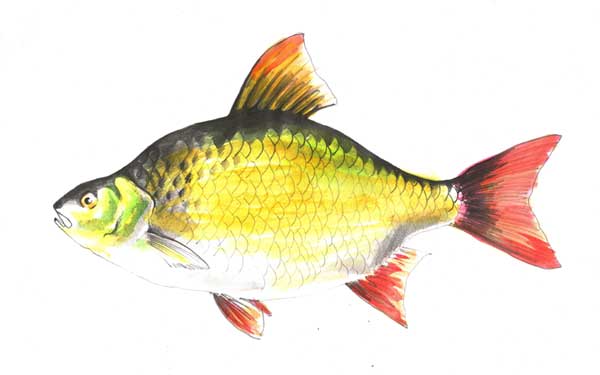
Rudd (Scardinius erythrophthalmus)
Current record: 4lb 10oz
Water: Clay Lake
The rudd (Scardinius erythrophthalmus) is a freshwater fish belonging to the Cyprinidae family, commonly found in rivers and lakes across Europe and Asia. Recognized for its distinctive appearance, the rudd is characterized by its silvery body, reddish fins, and upturned mouth. This species plays a significant role in both aquatic ecosystems and recreational fishing pursuits.
Rudd prefer slow-flowing or still waters with abundant vegetation, where they can find a variety of food sources. They are omnivorous, feeding on aquatic insects, small invertebrates, and plant matter. The rudd's diet contributes to the regulation of insect populations and nutrient cycling in freshwater ecosystems. Their silver coloration and reddish fins make them visually appealing, and their behavior often involves swimming in shoals near the water's surface.
Anglers appreciate the rudd for its sporting qualities, as it is known for its aggressive feeding behavior and responsiveness to various fishing techniques. Bait fishing, lure fishing, and fly fishing are commonly employed to target rudd. Due to their abundance and cooperative nature, rudd provide an enjoyable experience for anglers of all skill levels. Their willingness to take bait and distinctive appearance add to their appeal as a sought-after species in recreational fishing.
Rudd are often confused with other members of the Cyprinidae family, such as roach and ide, due to their similar appearance. However, the reddish coloration of the fins and the distinctive upturned mouth are key features that help distinguish the rudd. Understanding these characteristics is crucial for accurate species identification, which is essential for responsible angling and fisheries management.
Conservation efforts related to rudd focus on maintaining healthy aquatic habitats, addressing water quality issues, and implementing sustainable fishing practices. Protection of spawning areas, preservation of vegetation-rich environments, and the prevention of invasive species introductions contribute to the well-being of rudd populations. By balancing the interests of anglers with the need to preserve aquatic ecosystems, conservationists work to ensure the continued abundance and vitality of rudd in freshwater environments.
This species can be mistaken for the roach (Rutilus rutilus) due to their similar morphologies. It can be recognised by its golden eyes. The roach's eye features a large red patch above the pupil that may or may not be noticeable. The rudd's mouth is tilted up so it may easily feed at the surface of the water. Even in very young fish, the dorsal fin is positioned more towards the rear. Normally, there are just one or two scales between the anal fins and the tip of the pelvic fins, but there are five on the roach.
Rudd favour vegetation-rich, clean waterways. When the temperature is higher than 18 °C, they also consume aquatic plants. In the top levels, they seek for moving prey. They favour mesotrophic conditions, although the roach and perch can occasionally be found together in waters with low nitrogen levels. Rudd seem to choose water that isn't acidic. It loves the shallow, weedy backwaters of rivers and lakes, where mature females can lay up to 200,000 eggs on vegetation that is submerged. Zooplankton, water insects, and occasionally other tiny fish are consumed by young rudd. Aquatic vegetation is the main food source for mature rudd, which measure approximately 18" in length and weigh about 3 pounds.